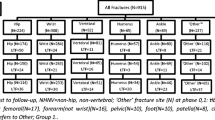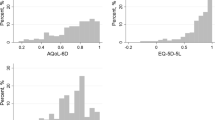Abstract:
The objective of the study was to estimate the impact of hip and vertebral fractures on quality of life in postmenopausal women using a preference-based health measure that is appropriate for economic evaluations and to investigate correlates of health outcome. Interviews to assess health-related quality of life, which also documented other health conditions and characteristics, were undertaken in women age 50 years and older without osteoporotic fractures compared with women with hip and/or vertebral fracture(s). Health status was characterized by self-reported physical limitations and the mental and physical component summary scores of the SF-36. Quality-adjusted life years (QALYs), which reflect each individual’s assessment of her overall health utility, were estimated with time tradeoff values. Regression methods were used to examine QALY correlates (e.g. time since fracture) for each fracture group and to estimate differences in QALYs between fracture and non-fracture subjects after accounting for other patient characteristics. Among 382 women ages 50–96 years, fracture subjects were significantly older, less likely to use hormone replacement therapy and more likely to report physical limitations than non-fracture subjects. On the QALY scale, where 1 represents perfect health and 0 represents death, mean QALY values were 0.82 (95% CI: 0.76, 0.87) among 114 women with one or more vertebral fractures and 0.63 (95% CI: 0.52, 0.74) among 67 with hip fracture compared with 0.91 (95% CI: 0.88, 0.94) among 201 women without fracture. No significant correlates of QALYs were identified among women with vertebral fracture alone. Among hip fracture subjects, time since hip fracture and presence of a vertebral fracture were significant correlates of QALYs. In multiple regression analyses, estimated QALY differences (fracture minus non-fracture subjects) ranged from –0.05 to –0.55 and were equivalent to losses of 20–58 days, 23–65 days and 115–202 days per year for vertebral fracture (p= 0.001), hip fracture (p= 0.009) and hip plus vertebral fracture (p<0.001) subjects, respectively, depending on age. Thus to adequately assess the cost-effectiveness of osteoporosis treatment, the negative impact of vertebral fractures on QALYs, even among women who have survived a hip fracture, must be considered.
Similar content being viewed by others
Author information
Authors and Affiliations
Additional information
Received: 2 February 2001 / Accepted: 23 July 2001
Rights and permissions
About this article
Cite this article
Tosteson, A., Gabriel, S., Grove, M. et al. Impact of Hip and Vertebral Fractures on Quality-Adjusted Life Years . Osteoporos Int 12, 1042–1049 (2001). https://doi.org/10.1007/s001980170015
Issue Date:
DOI: https://doi.org/10.1007/s001980170015




